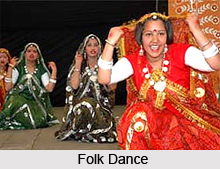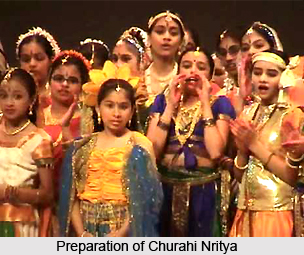Introduction
 Dance and Music form an inseparable aspect from the lives of people in Himachal Pradesh. Himachal Pradesh is an Indian state which is known for its vibrant colors of both the people and their culture. Variant folk dances are performed on every auspicious occasion and festival. The performances draw a high influence from the mythological epics of the Mahabharata and Ramayana. The folk music also displays identity and tribal culture of the people. It is based mainly on affection, separation, seasons and gallantry. Men and women get decked up in their traditional attires and dance to glory.
Dance and Music form an inseparable aspect from the lives of people in Himachal Pradesh. Himachal Pradesh is an Indian state which is known for its vibrant colors of both the people and their culture. Variant folk dances are performed on every auspicious occasion and festival. The performances draw a high influence from the mythological epics of the Mahabharata and Ramayana. The folk music also displays identity and tribal culture of the people. It is based mainly on affection, separation, seasons and gallantry. Men and women get decked up in their traditional attires and dance to glory.
Folk Dances of Chamba
 Folk dances of Chamba District hold special significance as here the local people enjoy both singing and dancing tremendously. Marriages, religious functions and fairs provide a spectacle of spontaneous songs and dances. Men and women may sing and dance separately or in mixed groups.
Folk dances of Chamba District hold special significance as here the local people enjoy both singing and dancing tremendously. Marriages, religious functions and fairs provide a spectacle of spontaneous songs and dances. Men and women may sing and dance separately or in mixed groups.
One of the most popular features of the folk dances of Chamba District is that it is slow in the beginning but picks up rhythm in between and becomes quite fast in the end. Singing and dancing go side by side. The general style of the dance consists of movements and steps, backward and forward in a circle formed by the dancer`s holdings hands. These folk dance forms are performed gracefully. The movements of steps are controlled by the pace set by the time of songs, drums, flute and tone. The various popular types of folk dances performed in Chamba District are as follows -
Dhurei: This dance is performed by the women folk only. In this pattern of dance, no musical instruments are played and the women dance on the tune of folk song. The dancers form a circle and dance. Some women sing supporting the dance form. This dance form was usually performed in the confines of the houses and therefore came to be known as `dhurei`, which means dance performed within a house. It is however believed that the dance acquired its name from the way it is performed. The dance is performed in circle called `ghera` in local parlance. From gehra, the word Ghurei has been derived. It is one of the most popular women dances in Chamba.
Churahi Nritya: This type of dance is more prevalent in Churah area as the name suggests. Men and women perform this dance by making circles. It is supported by musical instruments and folk songs.
Dandaras: This pattern of dance is performed in Bharmaur area by the inhabitants called Gaddis. It is a typical dance performed by men folk only. Dancers perform on the tune of musical instruments only. The dancers arrange themselves in a semicircle and begin dance in a slow speed. The dance picks up momentum in between and becomes very fast towards the end. The fast dance seems to symbolise `tandava nritya` of Lord Shiva.
Sohal Nati: This is a typical dance performed in Saho area of Chamba District. It is performed on all festive occasions but the main performance is on the days of Saho fair held in the Baisakh month in the premises of Chandershekhar temple. The dance symbolises the killing of Bhasmasura by Lord Vishnu and hence also known as `Mohini Bhasmasura` dance. This dance form is supported by musical instruments.
Dangi
It is one of the oldest and important folk dances of Himachal. It involves mainly female dancers. It is performed during the harvest seasons inside the temple of a Goddess known as Naina Devi. The dance has different variations to it. One theme depicts transactions of business amongst client and the businessman and the other depicts love story of a majestic king with a common village girl. The dance is loaded with vigor and enthusiasm with plethora of different shades of emotions.
Chhanak Chham
It is performed as a tribute in the memory of the divine Lord Buddha. The lahaul is a region in spiti valley where the lamas perform the devotional dance for the occasion of Chakar which takes place only once in three years. A classical head gear is worn during the performance. The costume has traditional patch work of motifs. The costumes are mostly black and golden fabric aiming to glimmer. The dancers carry swords and knives with their faces covered in black masks. They make slow and circular movements. The musicians play a long pipe like structure known as “Tangchim†and the drums known as Ghhan.
Namagen
The autumnal hue is celebrated in the month of September in the Himachal and for the celebration of this festival the Namagen dance is performed. The most striking dance performance amongst these is the Gaddis. The costumes that are used in this dance are of woolens and women wear richly studded ornaments of silver. The dancing steps & rhythm of the dance is wonderfully mixed with each other. Drum plays an important part in this dance performance.
Karayila
The most interesting and equally popular folk drama of Himachal Pradesh is Karayila. This drama includes an entertaining series of small playlets, skits, variety shows and parodies. This form of shows present sharp and pungent satires about the bureaucracy and social issues very boldly.
Losar Shona Chuksam Dance
The Losar Shona Chuksam is an agricultural festival dance performance. Losar refers to the New Year of the Tibetan people and it is performed by the Kinnauris in their typical style. The dancing steps depict all activities that are related with farming from sowing to reaping barley and phaphar (a local grain). The dance performance also includes innovative performed in the form of mime.
Nati
This dance has various forms which vary from region to region. The popular ones include the Kinnauri Nati, Gaddi Nati, Kullu Nati, Shimla Nati and etc. Each of them has an authentic style, music and costume distinguishing from the rest. Kinnauri Nati is performed during new festivals. The dancers portray the nature of trees, hills and smooth flowing rivers. Kullu Nati has thirteen forms in itself and performed during the Dusshera festival predominantly. The performers wear colorful tunics and sway themselves to the tunes of music. It is performed continuously till the musicians and dancers get drained of their energy. It is also performed in carnivals. The Nati dance has two purposes; one is for celebrating the New Year whereas the other is for celebrating the rich harvest produced after the hard work in fields.
Thoda Dance
It is a war dance which is performed before the men head out for war. It has old rituals associated with it, which are performed by holding an arrow and bow in hands. The dancers attempt to mimic battle scene through dancing.
Mala Dance
The Kayang Mala dance happens to be one of the popular dance forms of the state. The dancers get dressed in their traditional finery. They weave their arms together for forming a crisscross like pattern in order to make them look like beads on woven garland. They drink a rice brew before performing this dance form.
Demon Dance
This dance form originated from Kinnaur and the nearby areas. The folks of Kinnaur dance are compared to deer. The dance is performed with demon masks. It represents attack of the demons over crops and the ritual of pursuing the evil away by forces of good. The performances are generally organized in areas where there is dense population. This type of community dance happens mostly during the festivals of Bishu and Chaitol. The women and men hold hands and dance. They have a leader known as Ghure whose footsteps are followed by others.
Dalshone and Cholamba Dances
These dance forms originated from the Ropa valley. In this dance form, there are patterns formed by the performers which look like coiled serpents. The Cholamba is performed generally whenever a tiger is killed. The skin of dead animal is stuffed and a gold ornament is put in its nose. The remains of dead is rotated after that and the people dance around it.
Other Folk Dances of Himachal Pradesh
Apart from these there are other tribal dances that are equally popular and performed on different festivals of the state like Shand and Shabu dance, Keekali dance, Nagas Kayang, Herki Kayang, Shuna Kayang etc. Shand and Shabu is generally performed at Buddhist gompas in the memory of the Buddha. Keekali dance is mainly performed by young girls. Nagas Kayang is the dance form where the movement of snakes is copied. The Herki Kayang happens to be faster in rhythm and it is danced generally at romantic occasions. It is performed by young women and men. The Shuna Kayang is danced in most of the villages. It has combinations of rhythm on both fast and slow movements. It basically represents scenes from life inside the village and forests.



















